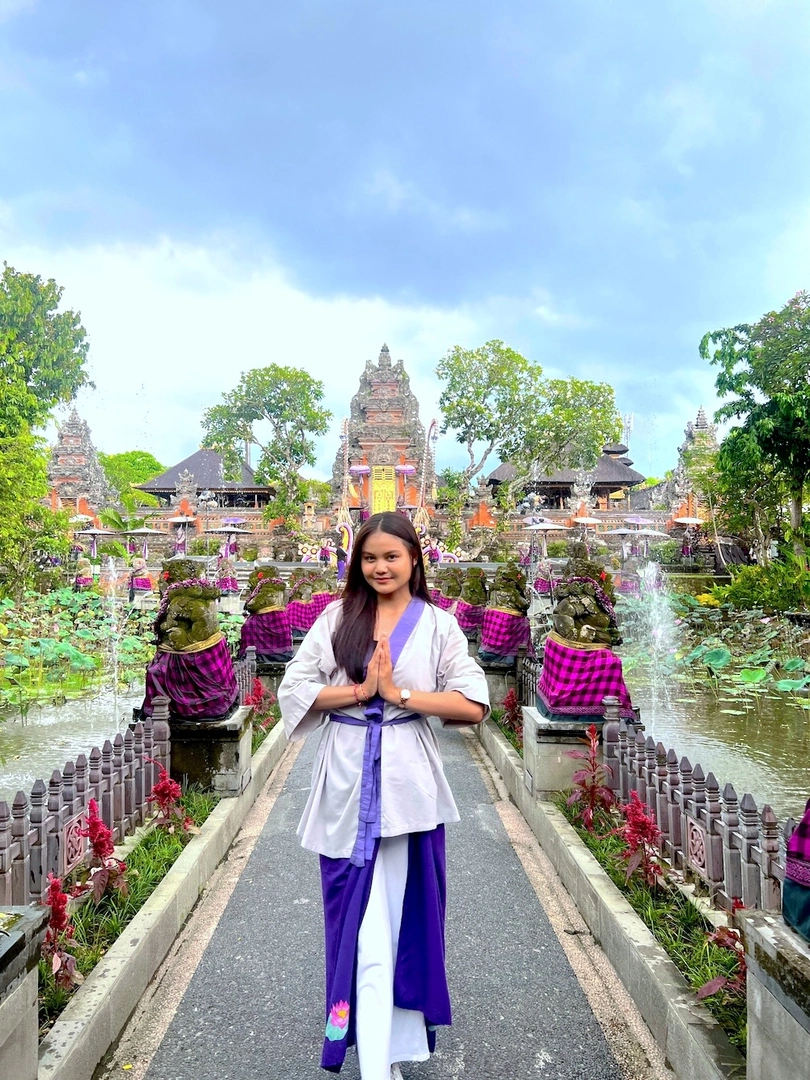Bali Temple Tour Guide: What to Say, Wear, and Avoid – Step into Bali’s sacred temples, where ancient traditions come alive and every step offers a deeper connection to the island’s rich spiritual heritage.
When you visit a Balinese temple, you’re not just stepping into a historical site—you’re entering a living, breathing spiritual space. It’s easy to be drawn in by the beauty of the ancient stone gates, fragrant incense, and colorful offerings. But behind every gesture and ritual lies deep meaning and tradition. If you want to truly experience a temple tour in Bali—not just as a visitor, but as a respectful guest—understanding the cultural etiquette is a must.Here’s your simple, respectful guide when join Bali Temple Tour.

Why Temple Etiquette Matters on a Bali Temple Tour
Temples, or pura, are central to Balinese Hindu life. They’re not tourist attractions by design—they’re active places of worship, where ceremonies and prayers happen every day. Being mindful of your behavior isn’t just about being polite—it’s about honoring a space that locals hold sacred. Your respect ensures you’re welcomed, and more importantly, it preserves the dignity of the tradition.

As I mentioned earlier, Bali’s temples are deeply sacred to the local people, and respecting this sanctity is key to having a meaningful experience. Temples are places where Balinese Hindus worship Ida Sang Hyang Widhi Wasa, their supreme god, and perform sacred rituals. So, it’s important to maintain reverence for the space and traditions, even as an outsider.

What to Say (And Not Say) on a Bali Temple Tour: Speak with Awareness
In Bali, there’s a concept called Tri Kaya Parisudha, which translates to thinking, speaking, and acting in a positive manner. This concept is fundamental to Balinese Hinduism and emphasizes kindness and respect in everyday life. As visitors, we should strive to honor this principle by:
Keeping your voice low, especially during ceremonies.
Avoiding jokes, loud laughter, or any remarks that might dismiss or interrupt rituals.
Approaching locals and temple staff with genuine interest and respect when asking questions.

If you’re unsure of something, always approach with humility. A simple “Om Swastiastu” (a Balinese greeting) can go a long way in showing respect.

What to Wear on a Bali Temple Tour: Modesty Over Fashion
Before stepping into any temple, your outfit should reflect humility. Both men and women are expected to wear:
A sarong to cover the legs.
A sash (selendang) tied around the waist.
- A kebaya (for woman)

Avoid revealing clothing like tank tops, shorts, or anything that shows too much skin. If you’re unsure, many temples rent out or provide sarongs at the entrance. Wearing the proper attire isn’t just respectful—it’s often required for entry.For men, a sarong or kamen (cloth wrap) is a suitable garment, and an udeng (headpiece) might also be necessary in certain temples, especially during ceremonies. At temples with holy water pools, like Tirta Empul, it’s important to note that sandals are not allowed when performing the sacred cleansing ritual in the water.o immerse yourself in the spiritual journey, join the Balinese Water Purifying Tour at Tirta Empul by Kura-Kura Bus, and witness the sacred purification rituals firsthand.
Book now: Balinese Water Purifying Tour at Tirta Empul by Kura-Kura Bus

What to Avoid on a Bali Temple Tour: Behaviors That Might Offend
Some actions that may seem harmless can actually be deeply disrespectful in a temple setting:
Don’t step over offerings (canang sari) placed on the ground. These are sacred gifts for the gods.
Never touch the head of a local, especially sulinggih(balinese priest), as it’s considered sacred in Balinese culture.
Avoid sitting or standing higher than the priest or holy items during a ceremony, as it can be seen as disrespectful.
Never point your feet directly at sacred objects or shrines. It’s considered offensive.

In general, always observe what others are doing or ask your guide for guidance. Respect for the sacredness of the space is essential to being a considerate guest.
Special Notes for Women
In Balinese tradition, women who are menstruating are considered to be in a state of cuntaka, which means they are ritually impure. This is a cultural belief that ties into the sanctity of temple spaces. Women in this condition are traditionally not allowed to enter the inner parts of temples.

If you visit during this time, you can still enjoy the outer areas of the temple and its surrounding grounds, but it’s best to avoid ceremonial spaces. This practice is part of Balinese spiritual purity, which should be respected by all visitors.
Photography Rules: Ask First, Respect Always
Bali’s temples are stunning, but before you snap a photo:
Never use flash, especially during ceremonies.
Don’t interrupt rituals for the sake of a photo.
If you want to take pictures of people, always ask for permission first.

It’s crucial to be respectful of people’s privacy and the sacred nature of the temple. Avoid climbing over walls or using flash photography, which could disturb both the ceremony and the temple’s spiritual environment.

Conclusion: Experience With Respect
A Bali temple tour can be one of the most meaningful parts of your journey if approached with the right mindset. Dressing appropriately, speaking gently, and being mindful of your actions transforms a sightseeing trip into a cultural connection.If you’re ready to experience Bali’s most sacred temples in a respectful way, join the Besakih and Karangasem Tour by Kura-Kura Bus. This tour takes you to the revered Besakih Temple and other royal heritage sites, providing local insights and cultural context to make your trip even more enriching.Book your tour now and explore Bali’s heritage in the most respectful and memorable way!
Eager to join us?
Click here secure your spot on the:Besakih and Karangasem Tour by Kura-Kura Bus


